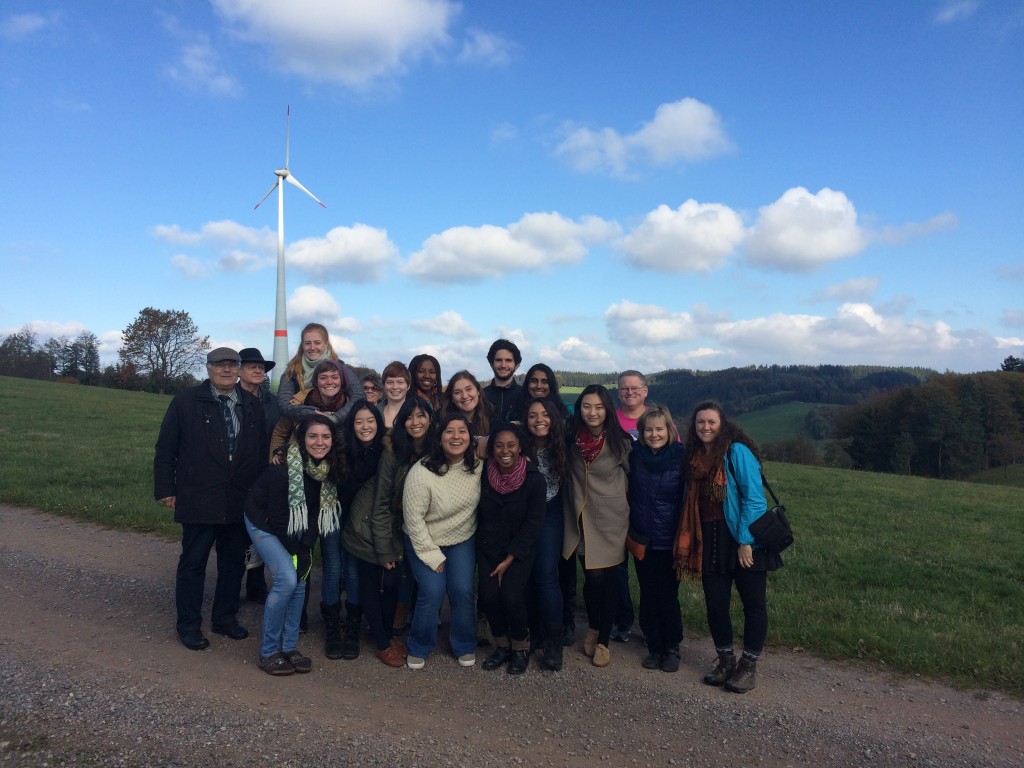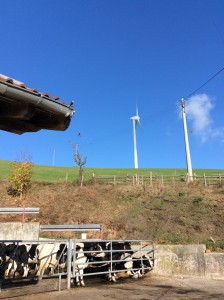When we woke up this morning, there were hopeful hints of blue skies behind the clouds, and by the time we had boarded our bus (the only private transportation we’ll take the entire trip), there were definite rays of sunshine. Today’s itinerary included several farms and other sites off the beaten track, including a series of windmills in the Freiamt region.
The community of Freiamt produces 200% of its electricity needs (twice as much as it needs each day) from renewable energy sources. We started our day by visiting a biogas plant that makes use of co-generation technology, allowing it to produce both heat and electricity by fermenting grass and manure gathered from the land, then burning the gas. The plant produces over one million kilowatt hours of electricity annually, and heats 19 apartments and the local elementary school.
The second farm we visited is more self-contained, where the wood pellet heating system is used to heat the house, and freshly collected milk is used to warm the household hot water (another example of heat transference co-generation). “This is apparently a 20-year-old technology that everyone has, and it’s mind blowingly obvious,” Mercedes explained. Reflecting further on the contrast between today and the rest of our trip, she notes “they have all of these technologies… at these places that are still farms. In my head, farms aren’t industrialized. But the idea that we have to use everything, in a pre-modernized lifestyle, is following this new sense of energy and renewable resources. We have all this stuff that we’re using so that it doesn’t go to waste. In Philosophy [class] we’ve talked a lot about modernization being finding new ways of needing unnecessary things. In this sense, [the renewable energy] technology is being created so as not to be wasteful, which is super cool.”
Rina, our other commentator, also found a lot of opportunities today to think about the bigger picture: “In class, Professor Dostal got us thinking about how much we are supposed to depend on technology, but I’ve realized that it’s all human connections that make this technology work. 108 people contributed to fund [one of] the wind turbine[s] we visited,” which is just a piece of technology. In class, the discussions have been around whether the possibilities include a human/technology co-existence or co-dependence, and whether human ability will be taken over by technology, or will be able to keep it in check. Rina thinks the success of Freiamt may mean that the connection is a balanced one.
The second half of our day was spent in the neighboring villages of Wyhl and Weisweil, home of the anti-nuclear protests of 1974 we’ve been referring to throughout the trip. Professor Carol Hager has done substantial research in the region, and she had the opportunity to present on her recently published book (NIMBY is Beautiful) to some of the people who are featured in it. First, though, we met with the vice mayor, who gave a brief overview of the protests. Rina has been impressed at the access to interesting people we’ve been granted, mostly through the connections of our faculty, and the Innovation Academy. “We got to talk to these bad ass women who kept a nuclear plant from being built – it’s everything we tell ourselves [as Mawrters] we want to be and everything we are told we can be, and the vice mayor was just there, telling us about it,” she said, about the interaction we had with the Women of Wyhl, who formed the backbone of the protests, since their bosses were more lenient, and their families were depending on their success.
After the book party, on our bus ride home, the class chatted about their takeaways from the day. These conversations often compare the German approach to US policy, but Mercedes realized that “our tours have been in villages and smaller places. We keep trying to apply things from St. Peter to Boston, but you’d have to get to a smaller suburb to draw the parallel. Going back to citizen engagement and involvement, the lessons here can’t be applied just anywhere.” Though it sounds a little down, she suggests that each community is an opportunity for someone to figure out the right set of circumstances and incentives to effect change in that particular space. Tomorrow, we will have more opportunities to learn about such initiatives, as we tour a solar-powered soccer stadium, a hydropower plant, and return to the community of Vaubon, for a look at the inside of an energy positive house.
About our guest commentators:
Mercedes Aponte is a sophomore, planning to declare a Geology major and Environmental Science minor. She was encouraged by past 360 students to look into the program, and thought this cluster would be a good way to explore her interest in Geology. Her hula hoop skills are pretty legendary, and she’s convinced she could light a lightbulb just by hula hooping, given the right energy gathering equipment. In other news, she almost fell into France at the Rhine today.
Rina Patel is a sophomore Growth and Structure of Cities major, originally from Chicago, where she used to host a game show for the largest science center in the western hemisphere. The show was called “It’s Predictable,” and she had a Bob Barker microphone. Her interest in 360s dates all the way back to her very first Bryn Mawr event, a presentation about the Modern Art 360 at the Art Institute of Chicago, where she sat with Jiji Plecha, of all people. Though her original plan was to just take the Political Science class, her Dean and Professor Hager convinced her that the whole 360 was worth it. She agrees.



